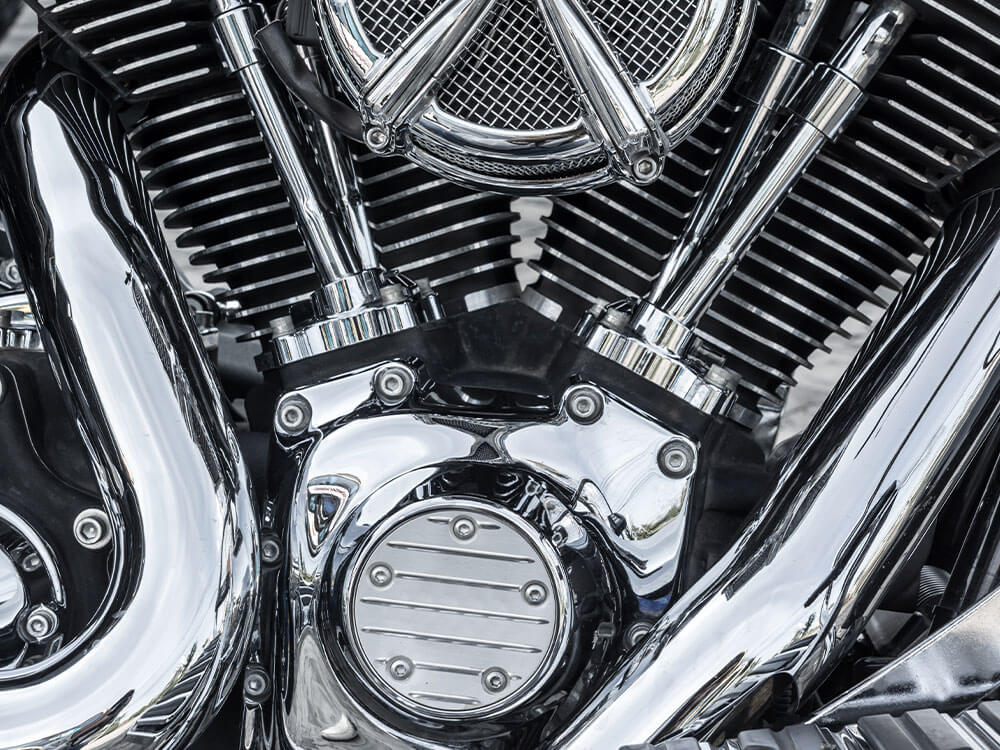Motorcycles have been a popular mode of transportation for decades, with millions of riders around the world enjoying the freedom and exhilaration of riding a two-wheeler. One of the most important factors to consider when buying a motorcycle is the type of cooling system it has. There are two types of cooling systems used in motorcycles:
Air-cooled and liquid-cooled. Each has its advantages and disadvantages, so choose the motorcycle with a cooling system that best suits your riding style and preferences.
This article discusses the differences, pros, and cons between air-cooled and liquid-cooled motorcycles.
Table of Content
| Features | Air-Cooled Motorcycles | Liquid-Cooled Motorcycles |
|---|---|---|
| Cooling System | Air-Cooled | Liquid-Cooled |
| Heat Dissipation | Lower | Higher |
| Engine Weight | Lighter | Heavier |
| Noise | Louder | Quieter |
| Maintenance | Less Complex | More Complex |
| Fuel Efficiency | Lower | Higher |
| Performance | Lower | Higher |
| Durability | Lower | Higher |
| Environmental Impact | Higher | Lower |
| Cost | Cheaper | Expensive |
1. Air-Cooled Motorcycles

Air-cooled motorcycles have been around for a long time and were the standard cooling system for many years before liquid-cooled systems became more popular. Air-cooled engines rely on airflow through the engine to dissipate heat. They don't have a separate cooling system like liquid-cooled engines, which makes them lighter and simpler in design.
Air-cooled motorcycles cool the engine naturally by allowing in outside air. To improve airflow, air-cooled motorcycle engines have fins on them. The fins increase the surface area of the motorcycle engine to ensure more exposure to incoming wind and promote quicker air exchange.
The main advantage of air-cooled engines is their high heat tolerance, ensuring the engine parts will continue to work even at extreme temperatures. This type of cooling system is best suited for harsh climates where winters are freezing and summers are scorching. The engine's components are designed to reduce metal expansion in extreme temperatures.
2. Liquid-Cooled Motorcycles

Liquid-cooled motorcycles are becoming more popular since most modern bikes have liquid-cooled engines. Liquid-cooled engines have a separate cooling system that circulates coolant (usually a mixture of water and antifreeze) around the engine to dissipate heat. The coolant travels through channels, absorbing heat from the engine before returning to the radiator to expel it. Sometimes you can even hear the whirling of the fan inside the reservoir. This occurs when the radiator's air input is not optimal and the fan forcefully draws in more air to disperse any excess heat. This makes them more efficient at keeping the engine cool, even in hot weather or when riding at high speed.
Liquid-cooled engines are designed to operate at a consistent temperature. If the liquid cooling mechanism fails, it might cause the pistons to seize up due to heavy expansion and engine damage.
3. Air-Cooled vs Liquid-Cooled Systems
3.1 Noise
Air-cooled motorcycles tend to produce more noise than liquid-cooled models. This is because the engine is exposed to the wind and doesn't dampen the sound as effectively as liquid coolant. Some riders prefer the raw, mechanical sound of an air-cooled motorcycle, while others prefer a quieter ride on a liquid-cooled model.
3.2 Efficiency
Liquid-cooled motorcycles are generally more efficient than air-cooled models. This is because liquid coolants can absorb and transfer heat more effectively than air. As a result, liquid-cooled motorcycles are better suited for high-performance riding and traveling in extreme weather conditions.
3.3 Engine Displacement
Whether an engine has an air-cooled or liquid-cooled system depends on its displacement. Motorcycles with high-displacement engines usually have liquid-cooled systems, while motorcycles with small-displacement engines typically have air-cooled systems.
3.4 Maintenance
Maintenance requirements differ between air-cooled and liquid-cooled motorcycles. Most air-cooled motorcycle engines are easier to repair, though this depends on the complexity of their designs. Regardless of their designs, air-cooled motorcycle engines are at least easy to diagnose. However, they are more susceptible to overheating and suffering engine damage in extreme conditions.
Meanwhile, liquid-cooled engines have more parts that need to be maintained. If there is an issue, check these components: the cylinder head, water jacket, and radiator. Liquid-cooled motorcycles require changing the coolant regularly and doing complex maintenance tasks.
3.5 Cooling Mechanism
The primary difference between air-cooled and liquid-cooled motorcycles is how they cool their engines. Air-cooled motorcycles rely on airflow, while liquid-cooled motorcycles use a liquid coolant to absorb and dissipate heat.
3.6 Weight
Air-cooled motorcycles tend to be lighter than liquid-cooled models since the latter has additional cooling components, including a radiator, a coolant pump, and hoses. This makes air-cooled motorcycles more nimble and easier to handle. Liquid-cooled engines have more weight due to the radiator, which reduces maneuverability, speed, and acceleration.
3.7 Climate
For liquid-cooled motorcycles, high temperatures can cause the engine to overheat, resulting in reduced performance, engine damage, or engine failure. In extreme cases, the engine can seize up and cause the motorcycle to lose control. To prevent overheating, liquid-cooled motorcycles typically include a thermostat that regulates the flow of coolant throughout the engine and a cooling fan that turns on when the engine gets too hot.
Meanwhile, air-cooled motorcycles are less affected by high temperatures since the air traveling through the engine helps dissipate the heat. However, in environments with high temperatures like a desert, an air-cooled engine can overheat and experience problems similar to liquid-cooled motorcycles. Air-cooled motorcycles may perform worse in cold weather due to the engine taking longer to warm up, resulting in reduced performance until the engine properly warms up.
3.8 Costs
In general, air-cooled motorcycles are less expensive than liquid-cooled models. This is because air-cooled engines have a simpler design and require fewer components. However, there are exceptions as the price may vary depending on the make and model.
3.9 Fuel Economy
Fuel economy depends on a motorcycle’s weight, engine, or weight of the rider and passenger. The heavier the motorcycle, the less fuel-efficient the engine will be.
Liquid-cooled motorcycles are heavier and have a lower fuel economy than air-cooled motorcycles.
3.10 Performance
Air-cooled motorcycles generally have lower power outputs and may struggle to perform at high speeds or while carrying heavy loads for extended periods. They are best suited for cruising or short commutes rather than long-distance tours or high-speed rides.
Liquid-cooled motorcycles can generally produce more power and can maintain performance at high speeds or while carrying heavy loads for extended periods. They are often suited for sport riding, touring, or high-performance rides.
3.11 Applications
Air-cooled motorcycles are often preferred by riders who value simplicity, a lightweight design, and a classic look. They are suited for riding in moderate climates with average temperatures.
Meanwhile, liquid-cooled motorcycles are preferred by riders who value high performance and reliable operation in almost any riding condition, including hot weather or high altitudes. They are suited for riding in extreme climates with fluctuating temperatures.
4. Pros and Cons of Air-Cooled Motorcycles
4.1 Pros of Air-Cooled Motorcycles
Lightweight and Simple Design
Air-cooled motorcycles have a simpler and lightweight structure that makes it easy to access components and reduces the weight of your ride.
More Reliable
Air-cooled motorcycle engines are more reliable as they have fewer parts that can break or malfunction.
Lower Cost
Air-cooled engines cost less to manufacture and maintain due to not having many complex components.
Better Durability
Air-cooled motorcycle engines are more durable and have a lower chance of failure.
4.2 Cons of Air-Cooled Motorcycles
More Noise
Air-cooled motorcycle engines tend to be noisier than liquid-cooled ones.
Limited Performance
Air-cooled motorcycle engines are less efficient at dissipating heat, resulting in lower power output and reduced performance.
Poor Heat Dissipation
Air-cooled motorcycle engines are more prone to overheating during long rides and when traveling at high speed.
Increased Engine Wear
Due to higher temperatures, air-cooled motorcycles can suffer engine wear much faster.
5. Pros and Cons of Liquid-Cooled Motorcycles
5.1 Pros of Liquid-Cooled Motorcycles
Quieter Operation
Liquid-cooled motorcycle engines tend to run more quietly than air-cooled engines.
Longer Engine Life
Coolant can increase a motorcycle engine’s lifespan and its parts by reducing temperature.
Easier Maintenance
Liquid-cooled motorcycle engines require less maintenance than air-cooled engines due to having fewer moving parts and suffering less wear and tear.
Better Performance
Liquid-cooled engines can maintain a consistent temperature, resulting in better performance and fuel efficiency.
5.2 Cons of Liquid-Cooled Motorcycles
More Weight
The additional components of a liquid-cooling system can increase your motorcycle’s weight, affecting handling and performance.
Higher Cost
Liquid-cooled engines are more expensive to produce and maintain than air-cooled engines, due to the extra parts.
More Complex
Liquid cooling systems have more complex designs, which can make them difficult to repair and maintain.
6. Last Words
Air-cooled motorcycles are simple, lighter, and less expensive but may not perform as well in high-temperature environments. Liquid-cooled motorcycles are more efficient and powerful but are more complex, require more maintenance, and can be more expensive. Ultimately, the choice between air-cooled and liquid-cooled motorcycles will depend on rider preferences and needs and the type of motorcycle.
You can install good-quality Viking Bags aftermarket parts to improve your motorcycle’s safety features and look, including SEATS, HANDLEBARS, FAIRINGS, CRASH BARS, and SISSY BARS. Viking Bags also offer various luggage options, including SADDLEBAGS, HANDLEBAR BAGS, SISSY BAR BAGS, and TANK BAGS.













Leave a comment
All comments are moderated before being published.
This site is protected by hCaptcha and the hCaptcha Privacy Policy and Terms of Service apply.